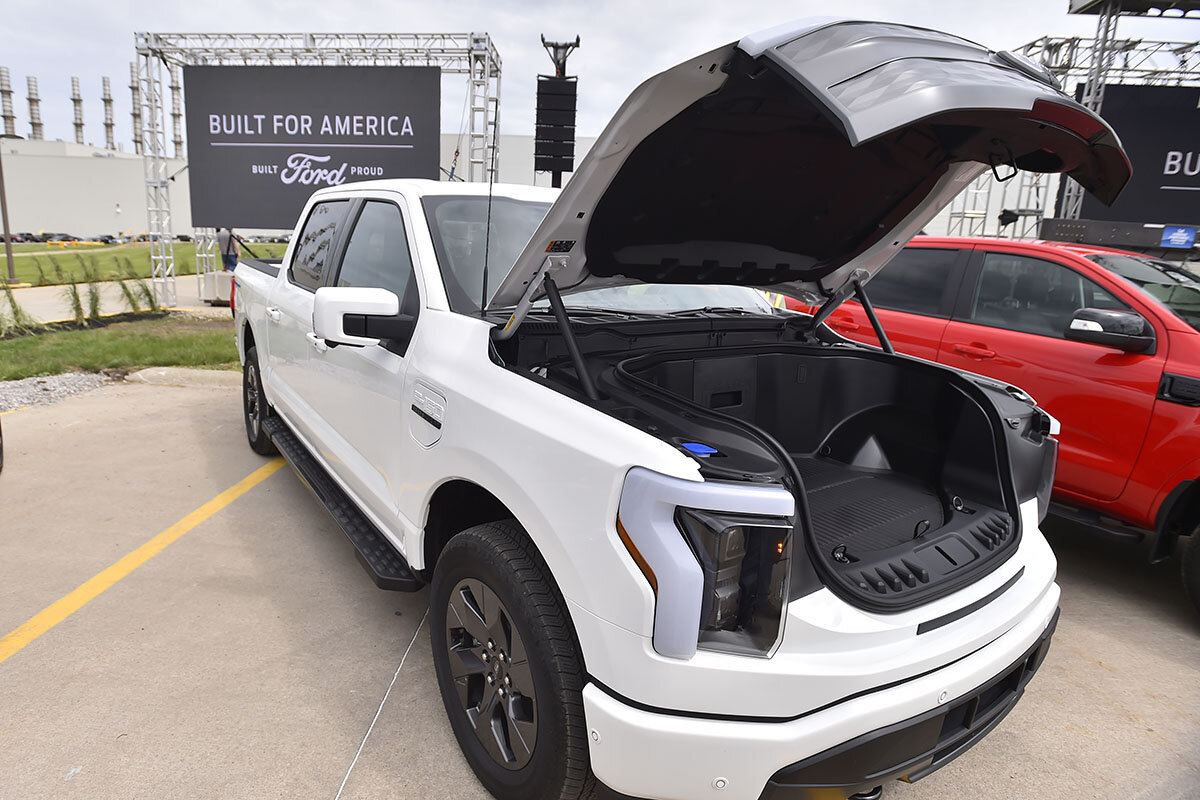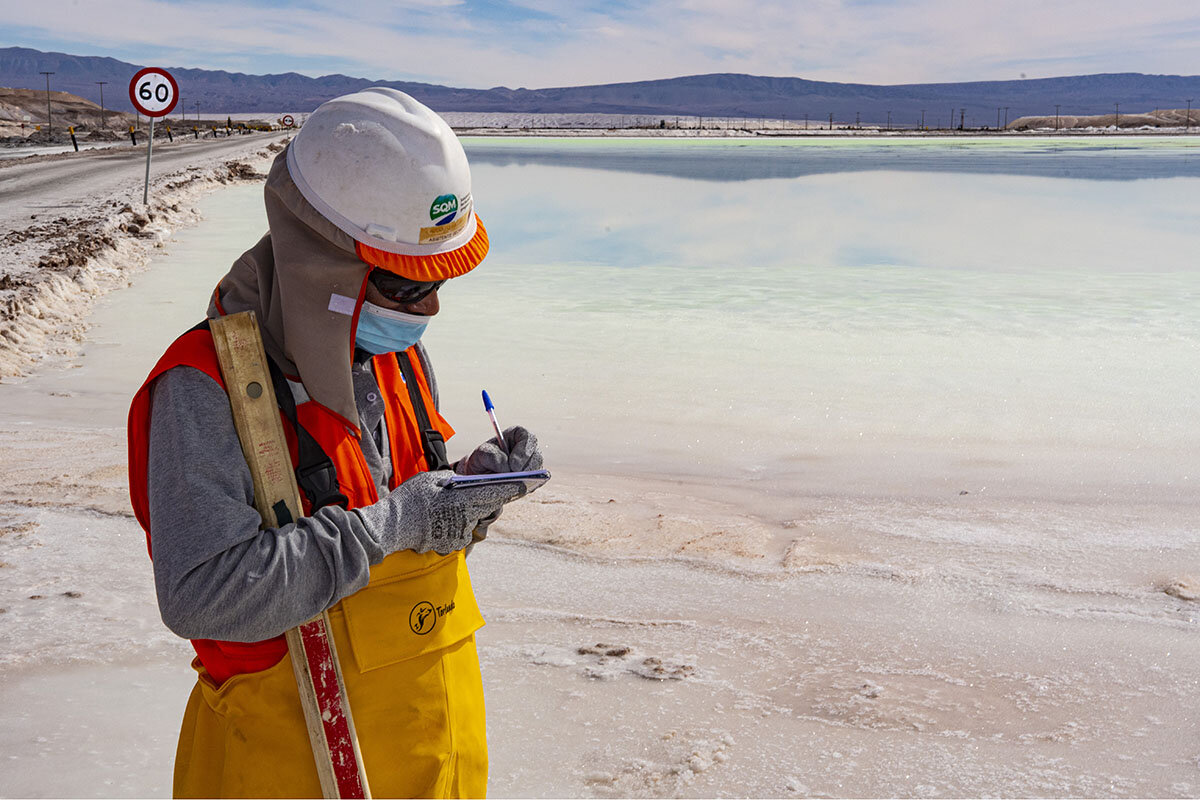Climate bill offers boost to EVs. Why short-term sales may slump.
Loading...
The outlook for America’s electric vehicles is bright. Sales and registrations of EVs are starting to rocket upward. President Joe Biden is poised to sign a climate change bill today that would shower drivers with even better incentives to go electric.
But those subsidies may short-circuit EV sales, at least for the short term. In trying to balance competing interests, Congress has passed a bill that will force automakers to diversify away from China, retool their supply chains, and make less expensive cars if they want their products to qualify for the incentives.
Why We Wrote This
The largest climate bill in U.S. history makes several trade-offs. There are subsidies for electric vehicles. But those come with asterisks about where materials are sourced.
There’s no question that the bill represents the United States’ boldest move yet to address climate change. Most of the funding goes toward reducing greenhouse gas emissions through tax credits and rebates for solar, wind, and other green technologies, including EVs. The vehicle portion of the bill illustrates the economic, environmental, political, and geopolitical trade-offs involved in trying to move the U.S. to a lower carbon future.
“There are always going to be these compromises,” says Erich Muehlegger, an economics professor at the University of California, Davis who has studied EV subsidies. “The real question comes down to, how do you balance these multiple objectives?”
The outlook for America’s electric vehicles is bright. Sales and registrations of EVs are starting to rocket upward. President Joe Biden is poised to sign a climate change bill today that would shower drivers with even better incentives to go electric.
But those subsidies may short-circuit EV sales, at least for the short term. In trying to balance competing interests, Congress has passed a bill that will force automakers to diversify away from China, retool their supply chains, and make less expensive cars if they want their products to qualify for the incentives.
There’s no question that the bill represents the United States’ boldest move yet to address climate change, causing House Democrats to cheer after passing it Friday and leaving Republicans fuming at the $437 billion in new spending and the $737 billion in taxes and other measures to pay for it. Although named the Inflation Reduction Act – its impact on inflation is expected to be negligible – the bill expands Medicare benefits and allows the federal government to negotiate some drug prices for Medicare. Most of the funding goes toward reducing greenhouse gas emissions through tax credits and rebates for solar, wind, and other green technologies, including EVs. The vehicle portion of the bill illustrates the economic, environmental, political, and geopolitical trade-offs involved in trying to move the U.S. to a lower carbon future.
Why We Wrote This
The largest climate bill in U.S. history makes several trade-offs. There are subsidies for electric vehicles. But those come with asterisks about where materials are sourced.
“There are always going to be these compromises,” says Erich Muehlegger, an economics professor at the University of California, Davis who has studied EV subsidies. “The real question comes down to, how do you balance these multiple objectives?”
EV advocates and major U.S. automakers applaud the bill. For one, it extends for 10 years the $7,500 federal tax credit and eliminates the current cap that begins reducing the credit once an automaker has sold 200,000 EVs. Tesla and General Motors have already exceeded that limit and are at a sales disadvantage vis-à-vis newer entrants. The legislation also makes the credit immediately available to car buyers, who can sign it over to their dealer and get the discount right away, rather than having to wait to file their taxes.
Used EVs also become eligible for a partial tax credit of up to $4,000.
Manufacturers will have to bring down their prices, however. The average EV today costs more than $66,000, Kelley Blue Book estimates. The subsidies will only be available for new cars that cost $55,000 or less, new trucks that cost $80,000 or less, and used EVs that cost no more than $25,000. That poses an especially big challenge for EV luxury makers, such as Rivian, which was scrambling to book deals before the president signs the act Tuesday.
Furthermore, the federal government doesn’t intend to subsidize rich EV buyers. Single buyers can’t earn more than $150,000 (joint filers, $300,000) to qualify for the new-car credit. The income limits for used EV buyers are half of what they are for new buyers.
The legislation contains more serious hurdles that will force automakers to retool in a hurry. One is a requirement that EVs must be assembled in North America to qualify for the subsidy. That’s a concern for big domestic manufacturers; it’s a deal breaker for foreign ones, such as Audi and Kia. Another challenge is that 40% of the critical materials used in an EV – a long list including everything from aluminum to yttrium, a rare earth element – must come from the U.S. or from nations that have a free trade agreement with the U.S. The requirement keeps increasing through 2027, when at least 80% of critical materials must come from mines in the U.S. or free trade partners.
Even more potentially difficult is the requirement that starting in 2025, no EV will qualify for the incentive that includes critical materials extracted, processed, or recycled by a “foreign entity of concern” – in other words, China. That’s in line with the Biden administration’s push to spur domestic manufacturing and reduce dependence on China, but it might reduce EV sales in the short term.
When the legislation goes into effect, 70% of EVs, plug-in hybrids, and fuel cell vehicles for sale in the U.S. will no longer qualify for the federal credit, warns John Bozzella, president of the Alliance for Automotive Innovation, which represents domestic and foreign manufacturers. When other sourcing requirements go into effect in the next few years, no EVs will qualify. The alliance’s solution: expand eligible countries to include those with a collective defense arrangement with the U.S., such as NATO nations and Japan.
The bill “reflects a growing commitment to scaling up EVs as a major component of the American economy,” says James Turner, an environmental studies professor at Wellesley College and author of a new book out today, “Charged: A History of Batteries and Lessons for a Clean Energy Future.” But “we need to give people time to adjust and resupply.”
Mining’s impact
The adjustment may require more than is readily apparent because of the control China holds over major portions of the EV battery supply chain.
Take cobalt. Congo (itself a less than ideal supplier because of its poor environmental record and reliance on child labor) produces 69% of the world’s supply, according to a new report from the Peterson Institute for International Economics. But only 3.5% of that supply comes from mining companies incorporated there. Chinese state-owned companies, by contrast, control about 24% of the known supply, the PIIE report calculates. (The ownership of a big chunk of cobalt production is not known.)
Lithium poses a similar challenge. The EV industry will need at least five times the lithium that was produced last year worldwide, according to industry estimates, perhaps more. And lithium prices already have skyrocketed because of surging demand. Although more than half of the world supply comes from Australia, Chinese state-owned companies actually control the top two miners there (an Australian and a Chilean firm) and about a third of the total market, according to the PIIE report.
The U.S. has a significant presence in Australian lithium mining, too, but its ownership is largely through passive investment firms, not state-owned companies controlled by a government. Several U.S. lithium projects have been proposed, but they would have to meet state as well as federal environmental rules and, in California, additional concerns about encroaching on sacred Native lands. More U.S. lithium would also mean more domestic lithium mining.
“Everything has an environmental impact, windmills and solar panels and lithium,” says James Van Nostrand, director of the Center for Energy and Sustainable Development at West Virginia University and author of a new book, “The Coal Trap: How West Virginia Was Left Behind in the Clean Energy Revolution.” The best lawmakers can do is “enforce the environmental laws and you try to minimize the environmental impacts.”
Political trade-offs
The EV boom doesn’t only mean more mining. There are other environmental trade-offs. For example, the U.S. will need less oil but more electricity to power its transportation. And that means increased nuclear power, says Mr. Van Nostrand, if the U.S. is to dramatically reduce its carbon footprint. The nation is currently on a trajectory to reduce 2005 emissions levels by 20% by 2030. The new bill could double that.
Then there are the political trade-offs. When President Biden first unveiled his Build Back Better initiative last year, Democratic liberals and moderates conducted a very public fight over its size and scope. Faced with midterm elections this fall and gloomy prospects for holding on to control of Congress, the liberals swallowed hard and lined up behind legislation heavily influenced by Democratic Sen. Joe Manchin of West Virginia. For example, the Inflation Reduction Act will fund clean coal initiatives, while liberals want to shut down coal production and allow more oil drilling on federal land and waters. The senator also won a deal to streamline approval of a West Virginia natural gas pipeline that many environmentalists oppose.
Even with all these trade-offs, Democrats embraced the plan as the best package they could get through a divided Congress. It squeaked by the Senate, 51-50, with Vice President Kamala Harris casting the tiebreaking vote, and the House, 220-207, along party lines.
“We can always point to drawbacks and things that could have been done better,” says Mr. Muehlegger at the University of California, Davis. “But this act is a very significant step forward.”










